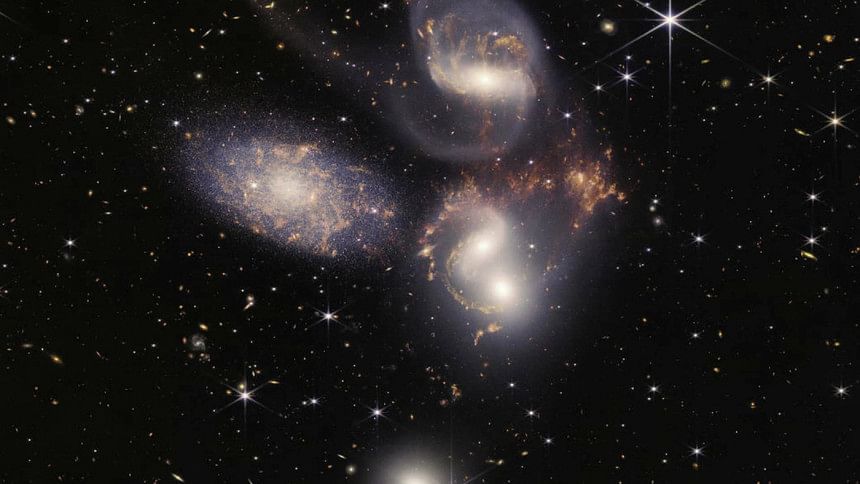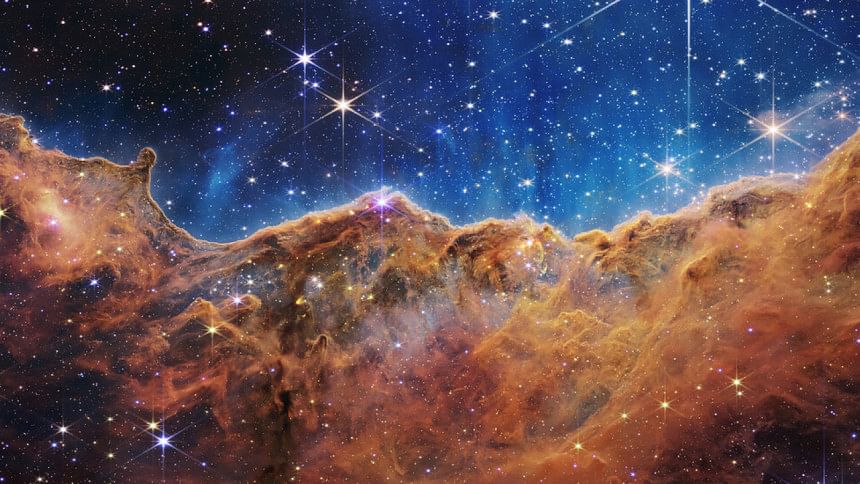What makes Webb’s first images such a big deal?

Renowned American astronomer Carl Sagan (1934-1996) famously said, "Somewhere [in the Universe], something incredible is waiting to be known." The first observations of the James Webb Telescope, released by Nasa earlier this week, put an end to the wait by presenting "humanity with a groundbreaking new view of the cosmos." Webb, as it is familiarly known, is telling the much-anticipated story of the hidden Universe through every phase of cosmic history – from revealing the atmosphere of a distant exoplanet, to providing stunning images of a "stellar nursery," to an explosive star in our galaxy – the Milky Way, to the deepest and sharpest view of the distant observable galaxies in the early Universe, and to everything in between.
The tantalising images have been widely published and discussed in newspapers, magazines, and electronic media across the entire globe. I will, instead, focus attention on five of the sensational discoveries by Webb: SMACS 0723, Southern Ring Nebula, Stephan's Quintet, WASP-96b, and the Carina Nebula.
SMACS 0723
The primary mission of Webb that was launched on Christmas day of 2021 is to look back in time over 13.5 billion years, which is closer to the beginning of time, and see some of the earliest galaxies to have formed in the Universe in the aftermath of the Big Bang about 13.7 billion years ago. To that end, Webb captured with amazing clarity the image of a distant cluster of galaxies called SMACS 0723 that originated more than 13 billion years ago. The image of the cluster revealed the presence of still more-distant galaxies spilled across the sky.
What made it possible for Webb to see the galaxies that were formed just after the Big Bang? The Universe, and thus every galaxy in it, is expanding. However, according to Einstein's General Relativity Theory, it is the space between the objects that actually stretches, causing the galaxies to move away from each other. Furthermore, any light in that space will also stretch, shifting that light's wavelength, initially shortwave and highly energetic, to low-energy, very dim and longer wavelengths. The phenomenon is similar to the siren from an ambulance that becomes less audible as it speeds by. Accordingly, light from distant objects reaches us as long wavelength infrared light that is invisible to the naked eye.
The James Webb Telescope, Nasa's successor to the Hubble Space Telescope, is specifically designed for observing infrared light from the primordial Universe. It can, therefore, access the previously invisible nascent cosmos when galaxies were formed.
Southern Ring Nebula

Although stars in the sky seem eternal and unchanging to us, their permanence is an illusion. Like us, stars are born, grow old and, at regular intervals, they die. Stars live for millions and billions of years because of thermonuclear reactions – fusion of hydrogen (fuel) into helium – in their cores. But a star has a limited supply of hydrogen. Consequently, massive stars, like gas-guzzling SUVs, use up their fuel rapidly and live shorter lives, while low-mass stars conserve their fuel, and shine for billions of years.
A dying star that has been cast in an entirely new light by Webb is the Southern Ring Nebula, approximately 2,000 lightyears away and visible in the southern hemisphere in the constellation Vela. It is a giant expanding sphere of gas and dust that has been lit up by a dying star in its centre. Webb's powerful infrared eyes bring a second dying star into full view for the first time. Ensnared in a tight orbit, the swirling duo has created a fantastic landscape of asymmetrical shells.
Although the Hubble Space Telescope's earlier view of the Southern Ring Nebula was spectacular in its own right, showing a huge smoke-ring-like cloud surrounding a brilliant inner star, Webb's view goes much further, showing not one but two stars at the heart of the nebula in much more detail.
Stephan's Quintet

About 290 million lightyears away, Stephan's Quintet (also known as Hickson Compact Group 92) is located in the northern constellation, Pegasus. Discovered in 1877, it is notable for being the first compact group of five galaxies ever discovered. Four of the five galaxies within the quintet are firmly bound and locked in a "cosmic dance" of repeated close encounters.
Webb pierced through the shroud of dust surrounding the centre of one galaxy, to reveal the velocity and composition of the gas near its supermassive black hole. Moreover, the telescope resolved in unprecedented detail a tapestry of fainter galaxies in the more distant Universe, together with sparkling clusters of millions of previously unseen stars in the galaxies. It even gathered the light generated by debris racing around a supermassive black hole.
Thanks to Webb, scientists can now get a rare look at how interacting galaxies are triggering star formation in each other and how the gas in these galaxies is being disturbed. They will also be able to determine why star birth in the quintet occurred at different epochs, stretching over hundreds of millions of years.
WASP-96b

The images made public by Nasa included the Webb telescope's first spectrum of an exoplanet called WASP-96b, one of more than 5,000 confirmed exoplanets in the Milky Way. Located more than 1,000 lightyears away from Earth, it has roughly half the mass of Jupiter and orbits extremely close to its Sun-like star within just 3.4 days.
Webb's detailed observation of this hot, gaseous planet outside our solar system reveals the clear signature of water in the form of water vapour in its atmosphere. Additionally, there is evidence of haze and clouds that previous studies of this exoplanet did not detect. With the first detection of water in the atmosphere of an exoplanet, Webb will now look for hundreds of similar systems in order to enable us to understand the composition of the atmospheres of exoplanets.
Carina Nebula

Webb's most striking image is of the Carina nebula, one of the largest and brightest nebulae in the sky some 7,600 lightyears from Earth. It is both a stellar nursery and home to some of the most luminous and explosive stars in the Milky Way. Seen in infrared, the nebula resembled a looming, eroded coastal cliff dotted with hundreds of stars that astronomers had never seen before.
Visible to the unaided eye, the Carina Nebula is the home of the Eta Carinae binary system, within which is a massive star – 250 times the solar mass – with a lifespan of less than 100,000 years, which is very short on a cosmic scale.
From 1838 to 1858, the star brightened to rival the light of Sirius, the brightest star in the sky, and then faded to a dim star. Since 1940 it has been brightening again, and scientists believe that the monstrous Eta Carinae will detonate in 10,000 to 20,000 years. It already underwent an outburst about 150 years ago, ejecting five solar masses of materials.
Webb's images of Carina Nebula showing cosmic precipices unveils the earliest rapid phases of star formation that were previously hidden. The images are teeming with brightly shining young stars, along with the remnants of supernova explosions marking the cataclysmic deaths of stars much more massive than the Sun.
Finally, looking further back in space and time than ever before, to within a few hundred million years from the moment the Universe exploded into being, Webb gifted us with a "ringside seat" to witness some mind-boggling events that are part of the history of the Universe. In the future, it will be able to reveal more unseen parts of our cosmos, and thereby, in the words of Joe Biden, will give us "a new window into the history of our universe."
Quamrul Haider is a professor of Physics at Fordham University in New York.

 For all latest news, follow The Daily Star's Google News channel.
For all latest news, follow The Daily Star's Google News channel. 





Comments